We all know the value of our employees, department and senior managers to our businesses. Within most  warehouses you can find staff that is dedicated and has longevity with the company. These individuals can most likely tell you exactly where most SKUs are located in the warehouse, which vendors have the most vendor compliance issues, and who the fastest pickers and packers are. This type of knowledge, “tribal knowledge”, is what makes things click in the warehouse.
warehouses you can find staff that is dedicated and has longevity with the company. These individuals can most likely tell you exactly where most SKUs are located in the warehouse, which vendors have the most vendor compliance issues, and who the fastest pickers and packers are. This type of knowledge, “tribal knowledge”, is what makes things click in the warehouse.
But for many companies, a negative form of tribal knowledge is a detriment to the short term and long term health and throughput of a company.
Let me give you an example. Recently we worked with a hard goods wholesaler on a warehouse assessment who needed to consolidate two facilities into one. When laying out the project plan for how the consolidation was going to be executed, it was quickly determined that 3,000 SKUs was going to take about 60 days just to do the move. The reason for this was only two individuals – maybe three – could identify SKUs in the warehouse. Further complicating the process was the fact that their systems in the old warehouse were antiquated and multiple SKUs per pick location, upwards of 25 to 30 SKUs were stocked in each location. There was no barcoding to assist with the process, and product descriptions were insufficient. The process would be much faster by having multiple teams identifying, cleaning, moving and put away merchandise into newly labeled stock locations.
Just so we’re all on the same page, “tribal knowledge” is any unwritten information that is not commonly known by others within a company. It is undocumented and handed down to new workers verbally. While tribal knowledge is of great value to businesses, it can seem to be contradictory to organization, process, IT systems, etc. Here are some other examples of tribal knowledge we run into operational assessment projects:
- Locating stock: The stock location for items is in people’s minds (“this is where I saw it yesterday”) rather than in the fulfillment or warehouse management system. There is no bin/slot location labeled on the racking and storage systems. The result is that it’s difficult to add new employees to stock functions, especially pickers. Additionally, if items are moved and people don’t keep up with the new locations, picking errors occur.
- Receiving: If you have a limited number of people that know your vendors, know your vendor compliance policies, or know the product assortment; the lack of process and procedures may make it difficult to receive products with additional people, leading to long dock to stock times;
- Managing inventory and locations: Without stock locations, there is inflexibility of slotting new receipts and managing cubic storage;
- Inventory accuracy: Cycle counting will be difficult without bar code marking of products and stock locations if people rely on memory for inventory location;
- Picking: If pick document and customer orders only have a SKU number or short/long description rather than stock location, picking will be more error prone; or
- Lack of written procedures: Without this, no one is doing the process or tasks in a uniform, acceptable manner. When no one else is able to perform that task or process, how will your company manage when that person (s) is out sick, takes a vacation or quits?
Companies must harness this tribal knowledge and use it to its advantage, but it can’t be held hostage by it – or you face serious financial risk that could negatively impact your customers.
During an operational assessment, take these steps to rid your company of the downside to tribal knowledge:
- Identify areas where processes are built around people, instead of people adopting acceptable processes and systems;
- Get the buy in of the employees to the benefits of formalizing and adopting procedures and common systems;
- Make sure managers get involved and approve the outcome;
- Set goals, priorities and schedule time for the project;
- Be sure to disseminate the knowledge to others so people can see the value to the company.
Don’t get overwhelmed with trying to do everything at once. Where would be get the most benefit or reduce the most risk?





SHARE